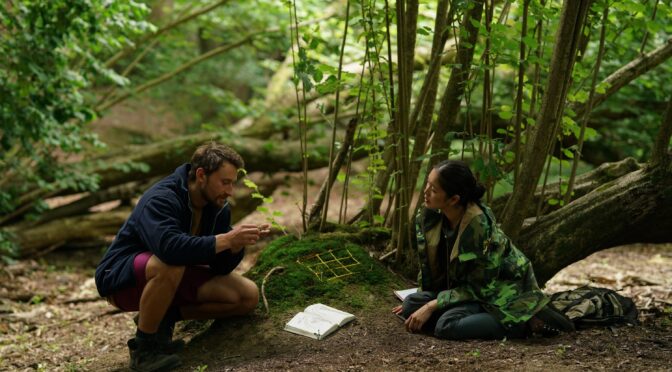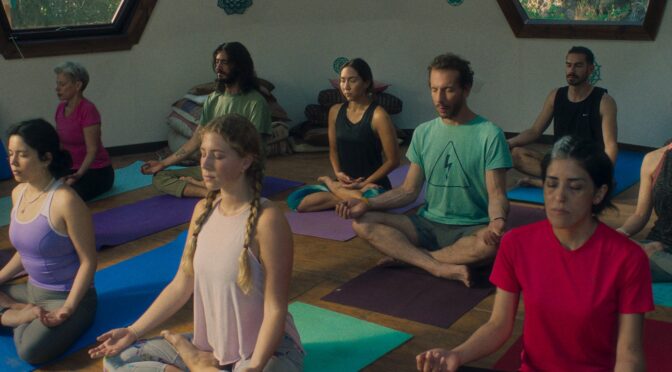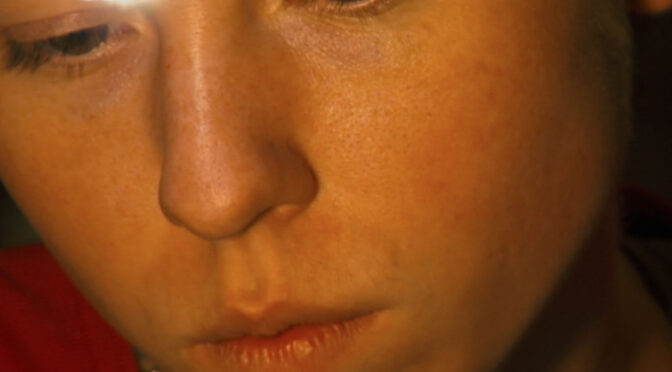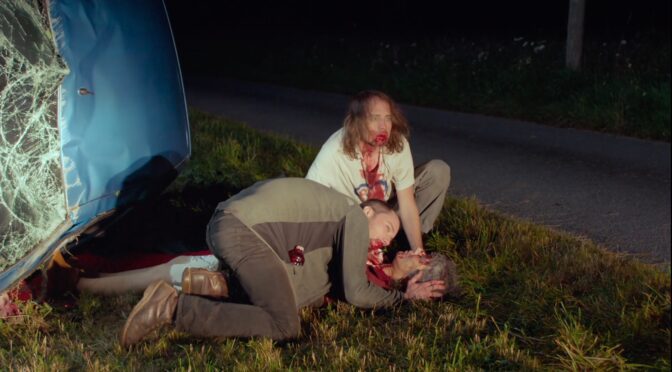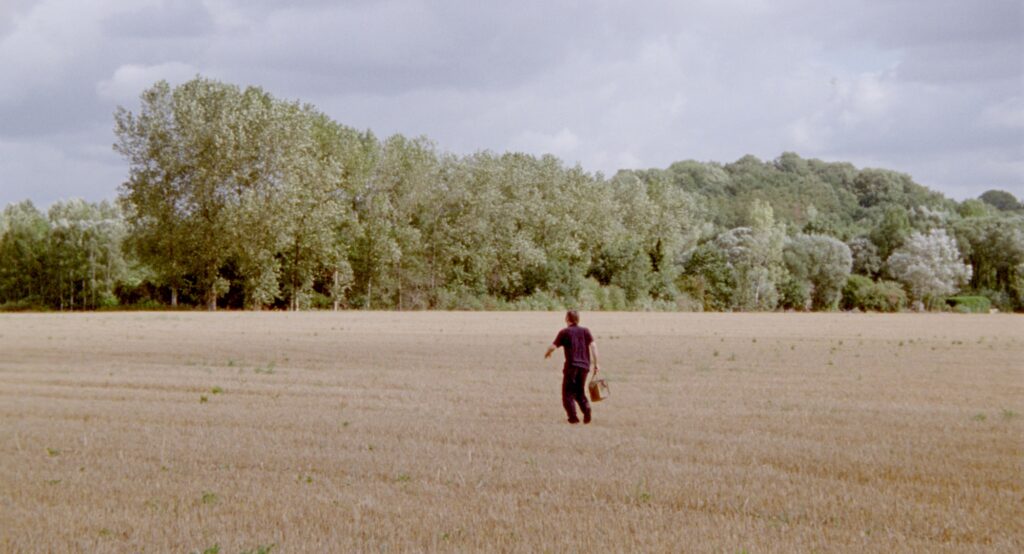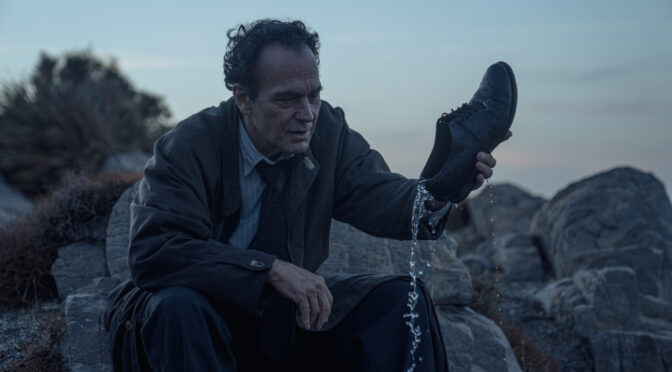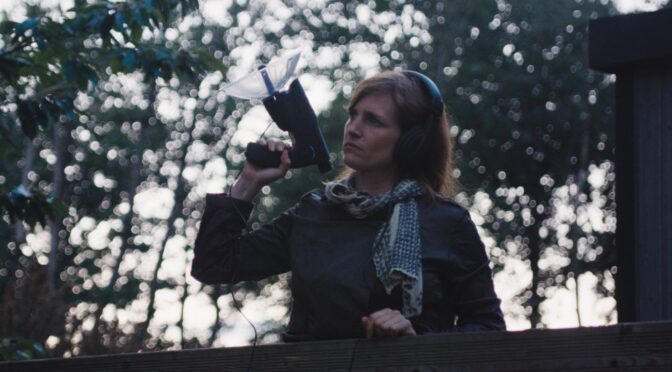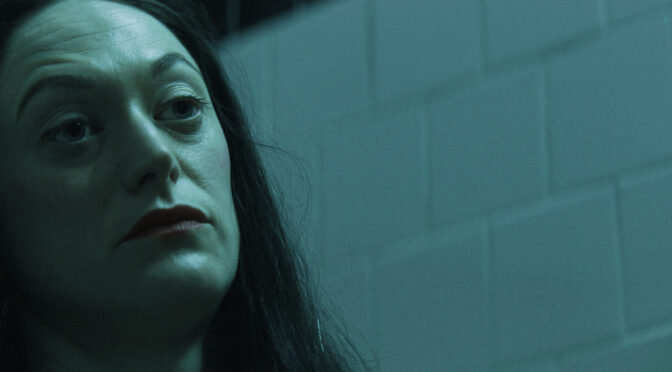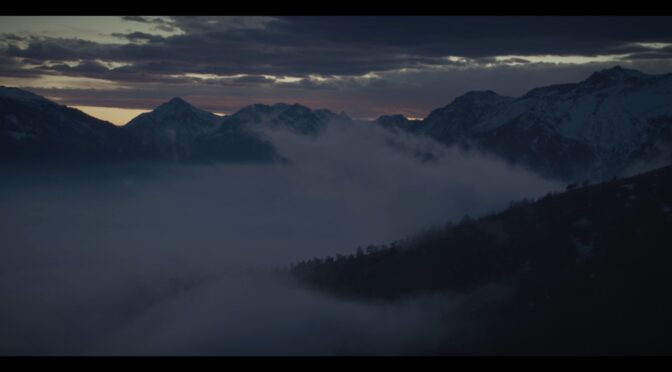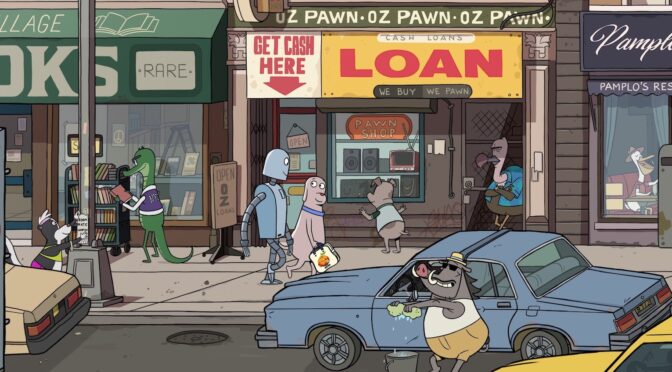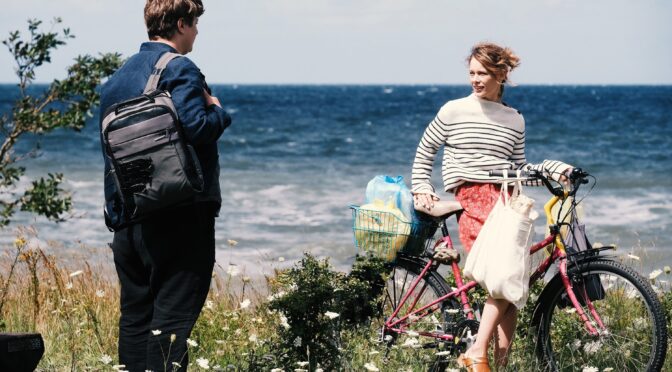Lui, Stefan (Stefan Gota), è un muratore insonne di origini rumene, dal viso arruffato e con i pantaloncini sempre corti; lei, ShuXiu (Liyo Gong), una vivace biologa di origini cinesi, dal dolce sguardo e spesso assorta. Entrambi vagano nella Bruxelles notturna e nei dintorni campestri, tra campi lunghi di palazzi in costruzione e dettagli di muschi e alberi mossi dal vento; si incamminano, si perdono e si ritrovano nel mondo di adesso – un bioma in cui la relazione di dipendenza uomo-natura progredisce in una stabile intesa.
Continua la lettura di “HERE” DI BAS DEVOS“LA PRÁCTICA” DI MARTÍN REJTMAN
Dopo più di trent’anni di carriera, per il suo ottavo lungometraggio La practica, Martín Rejtman abbandona la sua adorata Argentina per il vicino Cile. Non una rivoluzione, ma una sorta di ritiro spirituale, esattamente come quelli provati dal protagonista Gustavo (Esteban Bigliardi) per ritornare in connessione con la pratica meditativa dello yoga. Sia il regista che il suo personaggio – come non mai alter ego del suo creatore – vedranno i loro sogni di innovazione scontrarsi con la realtà. Infatti, come da prassi nel cinema del maestro argentino, il vortice di vicende che coinvolge gli inermi soggetti non produce alcun effetto sostanziale nelle loro vite, risolvendosi in un grandissimo nulla di fatto.
Continua la lettura di “LA PRÁCTICA” DI MARTÍN REJTMAN“LA PRÁCTICA” BY MARTÍN REJTMAN
Article by Enrico Nicolosi
Translation by Alessia Licari
For his 8th feature-length film, La Práctica (“The practice”), Martín Rejtman leaves his beloved Argentina for neighbouring Chile. The main character, Gustavo (Esteban Bigliardi), goes through a journey that is similar to a spiritual retreat trying to reconnect with meditative yoga. Both the director and the main character – who is sort of an alter ego of his creator – will see their innovative dreams clash with reality. As it often happens in the Argentinian director’s films, whatever happens to the helpless characters doesn’t really have a substantial effect in their lives.
Continua la lettura di “LA PRÁCTICA” BY MARTÍN REJTMAN“TIGRU/DAY OF THE TIGER” by Andrei Tănase
Article by Carlotta Pegollo
Translation by Carolina Criscuolo
A woman stands beyond a net, armed with a rifle, peering into the empty pool below where a caged tiger, the pet of a gangster, lies.
This marks the beginning of Andrei Tănase’s film, developed as part of the TorinoFilmLab 2019 which globally premiered at the International Film Festival Rotterdam 2023. The opening scene introduces the two main characters, their connection is evident through the first frames.
Leggi tutto: “TIGRU/DAY OF THE TIGER” by Andrei Tănase Continua la lettura di “TIGRU/DAY OF THE TIGER” by Andrei Tănase“TIGRU/DAY OF THE TIGER” di Andrei Tănase
Una donna al di là di una rete, armata di fucile, guarda in basso sul fondo di una piscina vuota dove si trova una tigre in gabbia, l’animale domestico di un gangster.
Così inizia il film Andrei Tănase – sviluppato nell’ambito del TorinoFilmLab 2019 e presentato in anteprima mondiale all’International Film Festival Rotterdam 2023 – con le due figure protagoniste, il cui legame è reso evidente dalla messa in quadro della prima scena.
“SOFIA FOI” BY PEDRO GERALDO
Article by Antonio Congias
Translation by Martina Agostino
What’s left of Sofia (Sofia Tomic) are clothes, laid out as if they were laundry hanging in the sun. What’s left of Sofia is the carving of a heart on a tree, the sound of a thud in the water, and the echo of a dog barking in the face of an irreparable choice. Even Sofia’s tattoo drawings survive, failing to fulfil the uncomfortable situation she ended up herself in. Actually, Sofia’s past and the memory of her last wanderings, are sealed in Sofia Foi, the debut feature film by Brazilian director Pedro Geraldo.
«Can we stay like this for a while?» says Sofia, sure that she no longer has to fear her vulnerability, because she finally has a person in front of her who can understand her fragility. A fictitious safety that is swept away by an outbreak of yellow fever, which turns Sofia’s life into a long tunnel where absence and the rumbling of death dominate.
Continua la lettura di “SOFIA FOI” BY PEDRO GERALDO“SOFIA FOI” DI PEDRO GERALDO
Quello che rimane di Sofia (Sofia Tomic) sono degli abiti zuppi di morte, stesi come se fossero panni al sole. Di Sofia resta l’incisione di un cuore sull’albero, il rumore di un tonfo nell’acqua e l’eco di un cane che abbaia davanti a una scelta irreparabile. Sopravvivono anche i disegni che Sofia tatua per venire meno alla situazione scomoda in cui si è trovata. Ciò che Sofia era, la memoria delle sue ultime peregrinazioni, è sigillato in Sofia Foi, opera prima del regista brasiliano Pedro Geraldo. «Possiamo rimanere così per un po’?» dice Sofia, certa di non dover più temere la propria vulnerabilità, perché finalmente ha davanti una persona che quella fragilità può comprenderla. Una sicurezza fittizia che viene spazzata via da un’epidemia di febbre gialla, che trasforma la vita di Sofia in un lungo tunnel in cui dominano l’assenza e il rimbombo della morte.
Continua la lettura di “SOFIA FOI” DI PEDRO GERALDO“Marinaleda” by Louis Séguin and “Michel Vay” by Nicolas Deschuyteneer and Patricia Gélise
Article by Pietro Torchia
Translation by Lara Martelozzo
Marinaleda by Louis Séguin, and Michel Vay by Nicolas Deschuyteneer and Patricia Gélise – two medium-length films presented at the Turin Film Festival in the Crazies section – address the road movie genre in opposite ways. In the former, the journey is a collective experience and becomes a pretext for enjoying the pleasure of sharing; in the latter, the journey is depicted as a metaphorical, intimate and private experience of the passage from an earthly dimension to a transcendent one. Marinaleda is a “political” road movie in which two vampires hitchhike from France to Spain to reach the town of Marinaleda, where a communist administration is in force. Amid new acquaintances, erotic moments and social discourses, it is the in-camera glances of the characters that capture the audience, inviting them to immerse in the vampire marxist-like philosophy of life according to which blood feasting becomes an altruistic gesture of body sharing – they are vampires of human and gentle nature with whom it is easy to empathize, in an atmosphere that reminds us of Jim Jarmusch’s Only Lovers Survive (2013), which also shares a fascination for slow narrative and a posed humour with Louis Séguin’s film.
Michel Vay tells of the introspective and transcendental escape journey of an outlaw who has just committed a robbery. A path to Michel’s death that moves between the concreteness of landscapes and the abstractness of the protagonist’s psychological torments, represented in the journey inside his mind through dance steps and music sounds. Attempting to narrate the passage between life and death, between the material and the immaterial in sixty minutes only, the film is at times overly ambitious, in a stylistic search for the perfect image that sometimes forgets the importance of audience involvement. A complacent nonlinear narrative that results in a didactic and predictable ending, with the concluding shot echoing the opening one, recalling a cyclical conception of life. A daring experimentation that is not perfectly successful and that not even the pleasant musical moments and Dantean quotations succeed to make truly exciting.
“Marinaleda” di Louis Séguin e “Michel Vay” di Nicolas Deschuyteneer e Patricia Gélise
Marinaleda di Louis Séguin e Michel Vay di Nicolas Deschuyteneer e Patricia Gélise – mediometraggi presentati al Torino Film Festival nella sezione Crazies – trattano il road movie in maniera opposta. Nel primo il viaggio è un’esperienza collettiva e diventa un pretesto per godere del piacere della condivisione; nel secondo, invece, è un’esperienza metaforica, intima e privata, del passaggio da una dimensione terrena a una trascendente.
Marinaleda è un road movie “politico”, nel quale due vampiri viaggiano in autostop dalla Francia alla Spagna per raggiungere la città, che dà il titolo al film, dove vige un’amministrazione comunista. Tra nuove conoscenze, momenti erotici e discorsi sociali, sono gli sguardi in macchina dei personaggi che catturano il pubblico invitandolo a immergersi nella marxista filosofia di vita vampiresca secondo la quale le banchettate di sangue diventano un gesto altruista della condivisione corporea. Vampiri dal carattere umano e gentile con i quali è facile empatizzare, in un’atmosfera che ricorda Solo gli amanti sopravvivono (2013) di Jim Jarmusch, che con il film di Louis Séguin condivide anche il fascino per la lentezza della narrazione e un posato umorismo.
Michel Vay racconta del percorso di fuga, introspettivo e trascendentale, di un fuorilegge che ha appena compiuto una rapina. Un percorso verso la morte di Michel che si muove tra la concretezza dei paesaggi e l’astrattezza dei tormenti psicologici del protagonista, mostrati nel viaggio all’interno della sua mente a passi di danza e suoni di musica. Tentando di narrare il passaggio tra la vita e la morte, tra il materiale e l’immateriale, in soli sessanta minuti, il film pecca di troppo ambizione, in una ricerca stilistica dell’immagine perfetta che talvolta dimentica l’importanza del coinvolgimento del pubblico. Una compiaciuta narrazione non lineare che sfocia in un finale didascalico e prevedibile, con l’inquadratura conclusiva che richiama quella iniziale, richiamando una ciclica concezione della vita. Una coraggiosa sperimentazione non perfettamente riuscita che neanche i piacevoli momenti musicali e le citazioni dantesche riescono a rendere veramente appassionante.
“CERRAR LOS OJOS” by Víctor Erice
Article by Fabio Bertolotto
Translation by Camilla Lippi
In Víctor Erice’s movies – four in a career that began fifty years ago – cinema, both as a physical place and as a technical and expressive device, has always played a central role. Her first feature film, The Spirit of the Beehive (El espíritu de la colmena, 1973), told the story of a little girl who was shocked after watching Frankenstein (James Whale, 1931). In El sur (The South) (1983) the protagonist discovered her father’s betrayal in a hall where movies featuring the man’s lover were shown. Cinema as an influential art device, capable of having concrete effects on reality, can also be found in Cerrar los ojos (Close your eyes), the director’s latest work.
Continua la lettura di “CERRAR LOS OJOS” by Víctor Erice“CERRAR LOS OJOS” di Víctor Erice
Nei film di Víctor Erice – quattro in una carriera iniziata ormai cinquant’anni fa – il cinema, sia come luogo fisico che come dispositivo tecnico ed espressivo, ha sempre ricoperto un ruolo centrale. Il primo lungometraggio, Lo spirito dell’alveare (El espíritu de la colmena, 1973), raccontava di una bambina sconvolta dalla visione di Frankenstein (James Whale, 1931). In El sur (1983) la protagonista scopriva il tradimento del padre in una sala dove venivano proiettati i film in cui recitava l’amante dell’uomo. Il cinema come immaginario influente, capace di avere effetti concreti sulla realtà, si ritrova anche in Cerrar los ojos, ultima opera del regista.
Continua la lettura di “CERRAR LOS OJOS” di Víctor Erice“Camping du lac” by Éléonore Saintagnan
Article by Elisa Gnani
Translation by Carolina Criscuolo
Climate change is not a fairy tale, and the director makes this clear. Éléonore Saintagnan immerses us in an unusual atmosphere, almost as if it was a science fiction film. I prefer to label it as a fictional feature teetering on the edge of reality — a film that calls into question a monster to shed light on a pressing issue: the drying up of lakes.
“Camping du lac” di Éléonore Saintagnan
Il cambiamento climatico non è una favola e la regista ce lo dimostra.La regista Éléonore Saintagnan ci fa immergere in una strana atmosfera, quasi come se quello che ci propone fosse un film di fantascienza. Mi piace definirlo un lungometraggio di finzione ai confini con la realtà: un film che chiama in causa un mostro per parlarci di un tema di attualità, il prosciugamento dei laghi.
Continua la lettura di “Camping du lac” di Éléonore Saintagnan“BIRTH/REBIRTH” BY LAURA MOSS
Article by Asia Lupo
Translation by Fabio Castagno
A little girl dies and is born again. This is the obsessive research of a maternity which makes the creation of life look like an unfulfilled purpose. What does the idea of parenting bodies and ideas mean? Can creation, intended as a prosthesis of ourselves in eternity, be a possible cure for death? The debut feature film Birth/Rebirth by director Laura Moss tries to answer these questions through the story of two totalizing and petrifying gestations.
Continua la lettura di “BIRTH/REBIRTH” BY LAURA MOSS“BIRTH/REBIRTH” DI LAURA MOSS
Una bambina muore e rinasce. La ricerca ossessiva di una maternità che fa del creare la vita uno scopo incompiuto. Che cos’è la genitorialità dei corpi e delle idee? La creazione, come protesi di noi stessi nell’eternità, può davvero essere una cura alla morte? Birth/Rebirth, lungometraggio di esordio della regista Laura Moss, prova a rispondere a queste domande attraverso un racconto di due gestazioni totalizzanti e pietrificanti.
Continua la lettura di “BIRTH/REBIRTH” DI LAURA MOSS“OLTRE LA VALLE” BY VIRGINIA BELLIZZI
Article by Marco Di Pasquale
Translation by Chiara Rotondo
Since we were kids, when being first shown a geographical map, political boundaries seemed so obvious and natural to us that we were ready to be tested at school. They may have changed over time, but they remain precise and defined at all times. Paradoxically, it is precisely when at the boundaries that we realise how much those lines we saw reproduced on maps are actually invisible, and how much the very concept of a border is artificial, aimed at reassuringly determining every aspect of our existence. It is in one of those places, in the municipality of Oulx, on the border between Italy and France, that Virginia Bellizzi observes the numerous fleeting passages of migrants in search of a better future.
Continua la lettura di “OLTRE LA VALLE” BY VIRGINIA BELLIZZI“OLTRE LA VALLE” DI VIRGINIA BELLIZZI
Quando, fin da piccoli, ci viene mostrata per la prima volta una mappa geografica, i confini politici ci appaiono scontati e naturali, pronti per essere memorizzati in vista dell’interrogazione. Sono sì cambiati nel corso del tempo, ma restano precisi e definibili in ogni epoca. Paradossalmente, è proprio nei luoghi di confine che ci si rende conto di quanto quelle linee che vediamo riprodotte sulle cartine geografiche siano in realtà trasparenti e quanto il concetto stesso di confine sia artificiale, finalizzato a incasellare in modo rassicurante ogni aspetto della nostra esistenza. È in uno di questi luoghi, nel comune di Oulx, al confine tra Italia e Francia, che Virginia Bellizzi osserva i numerosi e fugaci passaggi di migranti in cerca di un futuro migliore.
Continua la lettura di “OLTRE LA VALLE” DI VIRGINIA BELLIZZI“ROBOT DREAMS” BY PABLO BERGER
Article by Angela Borraccio
Translation by Rebecca Lorusso
The Spanish director Pablo Berger and the Arcadia Motion Pictures renew their collaboration to create their first 2D animated film. As with the previous Blancanieves (“Snow White”, 2012) – a black and white silent film – the director feels the need to reconnect with the essence of early 20th century cinema. For Robot Dreams he also looks back to the past, specifically to traditional animation, fascinated by its unlimited possibilities of storytelling and representation. Berger succeeds in tackling the challenge of the step-by-step technique – or, frame by frame – with ease, thanks to the habit of creating storyboards, which allowed him to integrate an ideal process for the development of animation.
Continua la lettura di “ROBOT DREAMS” BY PABLO BERGER“ROBOT DREAMS” DI PABLO BERGER
Il regista spagnolo Pablo Berger e l’Arcadia Motion Pictures rinnovano la collaborazione per creare il loro primo film in animazione 2D. Come per il precedente Blancanieves (2012) – muto e in bianco e nero – il regista sente il bisogno di ricongiungersi con l’essenza del cinema dei primi decenni del Novecento. Anche per Robot Dreams volge uno sguardo al passato, nello specifico all’animazione tradizionale, affascinato dalle sue illimitate possibilità di narrazione e rappresentazione. Berger riesce ad affrontare la sfida della tecnica a passo uno (frame by frame) con semplicità, grazie all’abitudine di creare gli storyboard che gli ha permesso di assimilare un processo ideale per lo sviluppo dell’animazione.
Continua la lettura di “ROBOT DREAMS” DI PABLO BERGER“Roter Himmel” by Christian Petzold
Article by Valentina Testa
Translation by Alessia Licari
The sky burns above Leon (Thomas Schubert), a hopeless author, as he is writing a book without first having thought of an actual story. Concern is evident on his face while he repeats to himself that others do not understand him, his clothes are always black and he often hides in the shadows, he lies in wait at the blind spot of a door window to peek at other people’s lives. He has a tattoo on his chest, barely visible and which can only be glimpsed behind the hem of his shirt: it looks like the perfect picture to represent someone who is almost afraid to be part of the real world.
Continua la lettura di “Roter Himmel” by Christian Petzold
